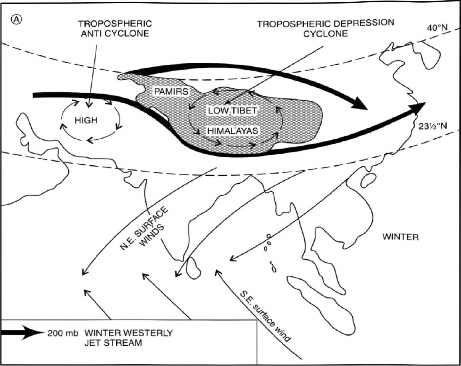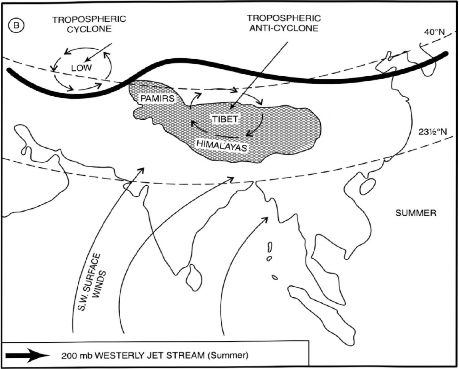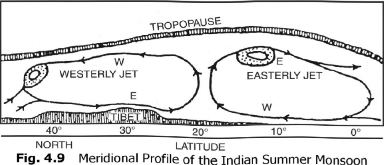INDIAN MONSOONS AND THE TIBET PLATEAU
In 1973, the Monsoon Expedition (Monex) was organised as a joint venture of the Soviet Union and India. Under this expedition, four Russian and two Indian ships equipped with modern scientific instruments were pressed into service in the Indian Ocean and the Arabian Sea to investigate the phenomenon of Indian monsoons. The period of investigation extended from the month of May to July, 1973. On the basis of the data obtained, the Soviet meteorologists arrived at the conclusion that the Tibet Plateau plays a crucial role in initiating the monsoon circulation over the Indian subcontinent. In 1958, Dr. P. Koteswaram, the Director General of the Indian Meteorological Observatories, while participatingin the international symposium on ‘The Monsoons of the World’ had expressed views that the summer-time heating of the Plateau of Tibet was the most important factor in the causation and maintenance ofmonsoonal circulation. The Indian as well as the Soviet scientists were unanimous in their views on this point.
The plateau of Tibet is 600 km wide in the west and 1000 km in the east. Its length from west to east is about 2000 km. The average height of the plateau is about 4000 m. Thus, it is an enormous block of high ground acting as a formidable barrier. Due to its enormous height it receives 2°C to 3°C more insolation than the neighbouring areas. It is also one of the most important geographical controls on the general atmospheric circulation in the region. The Plateau of Tibet affects the atmosphere in two ways, acting separately or in combination; (i) as a physical barrier, and (ii) as a high-level heat source. The meridional cross- section of the Indian summer monsoon and its relationship with the Tib etan-Himalayan massif has been shown in Fig. 4.7 and Fig. 4.8.

Fig. 4.7 Cross Section of the Indian Summer Monsoon
According to Maung Tun Yin, the Tibetan Plateau acts as a physical barrier. At the beginning ofjune, the subtropical jet stream disappears completely over northern India (Fig. 4.8). At this time, the jet stream shifts to the north of the Himalayas and Tibet, and takes up a position at about 40° N. Yin considers that there is a correspondence between the shifting of the jet and the slowing down of the westerlies over the whole of Eurasia. In fact, the plateau of Tibet becomes very cold in winter, and proves to be the most important factor in causing the advance of the jet far to the south in the middle of October. Thus, he opines that the abrupt onset of summer monsoon at the beginning ofjune is prompted by the hydro-dynamic effect of the 1 limalayas and not by the thermally induced low pressure centre over northwest India. In the middle of October, the plateau proves to be the most important factor in causing the advance of the jet south of the Himalayas or bifurcate it into two parts (Fig. 4.7).
The summer-time heating of the Tibetan Plateau makes it a high-level heat source. This ‘Heat Engine’ produces a thermal anticyclone over this region. A warm core anticyclone (high pressure) is formed over this plateau during the summer monsoon period. The formation of this anticyclone takes place in the middle part of the troposphere at 500 mb level. It is the result of a process called

Fig. 4.8 Monsoon and the Tibetan-Himalayan Highlands
anti-cyclogenesis. The anticyclone at 500 mb at Tibet weakens the western sub-tropical jet-stream south of Himalayas, but produces tropical easterly jet on the southern side of the anticyclone. This tropical easterly jet stream first develops in longitudes east of India and then extends westwards across India and the Arabian Sea to eastern Africa. Blowing along Kolkata-Banglore axis the air under this jet descends over the Indian ocean and intensifies its high pressure cell, so as to finally move as south-west monsoon. The data collected under Monex support that higher the inensity of the tropical easterly jet greater would be potency of the high pressure cell over the Indian Ocean and stronger would be impact of south-west monsoon. Fig. 4.9 shows the meridional cross section

of the westerly and easterly jet-streams and their relationship with the Tibetan Plateau. However, on the southern side of this upper air anticyclone, the direction of air flow is from east to west. In fact, these easterly winds blowing in the mid-troposphere are known as tropical easterly jets. Fig. 4.9 shows the meridional cross section of the Indian summer monsoon and its relationship with the Tibetan-Himalayan Highlands.
